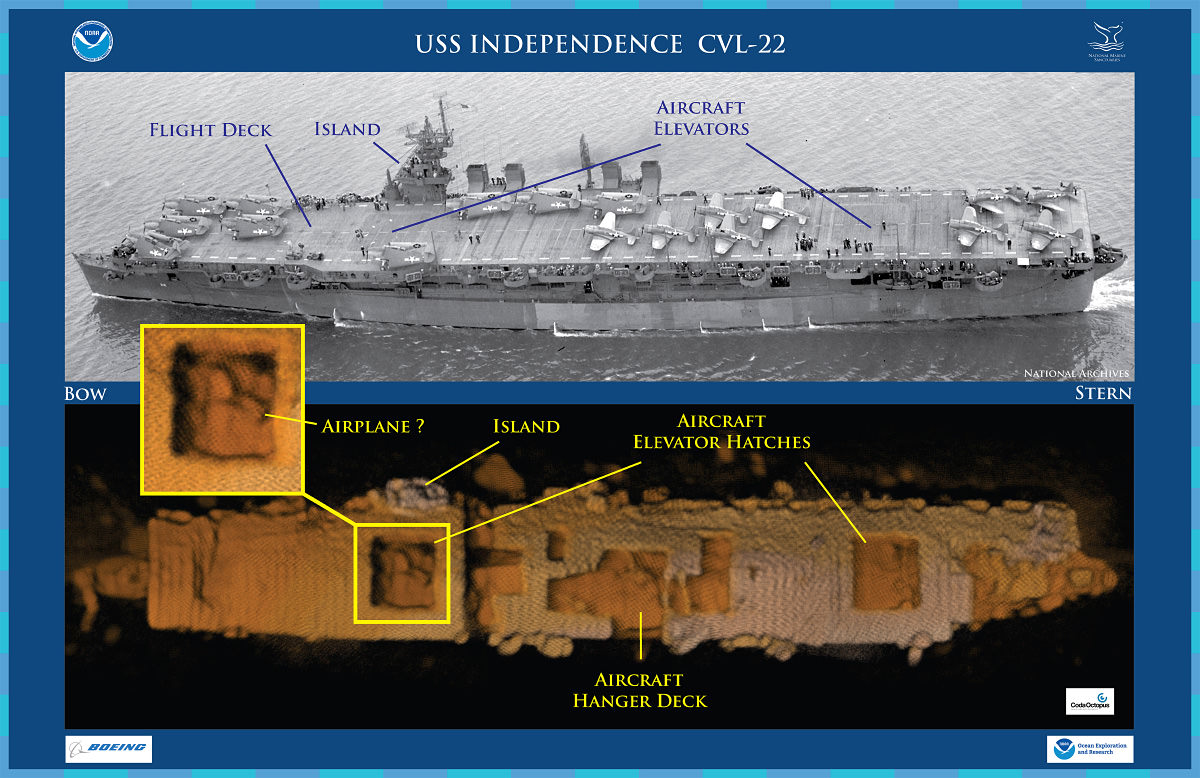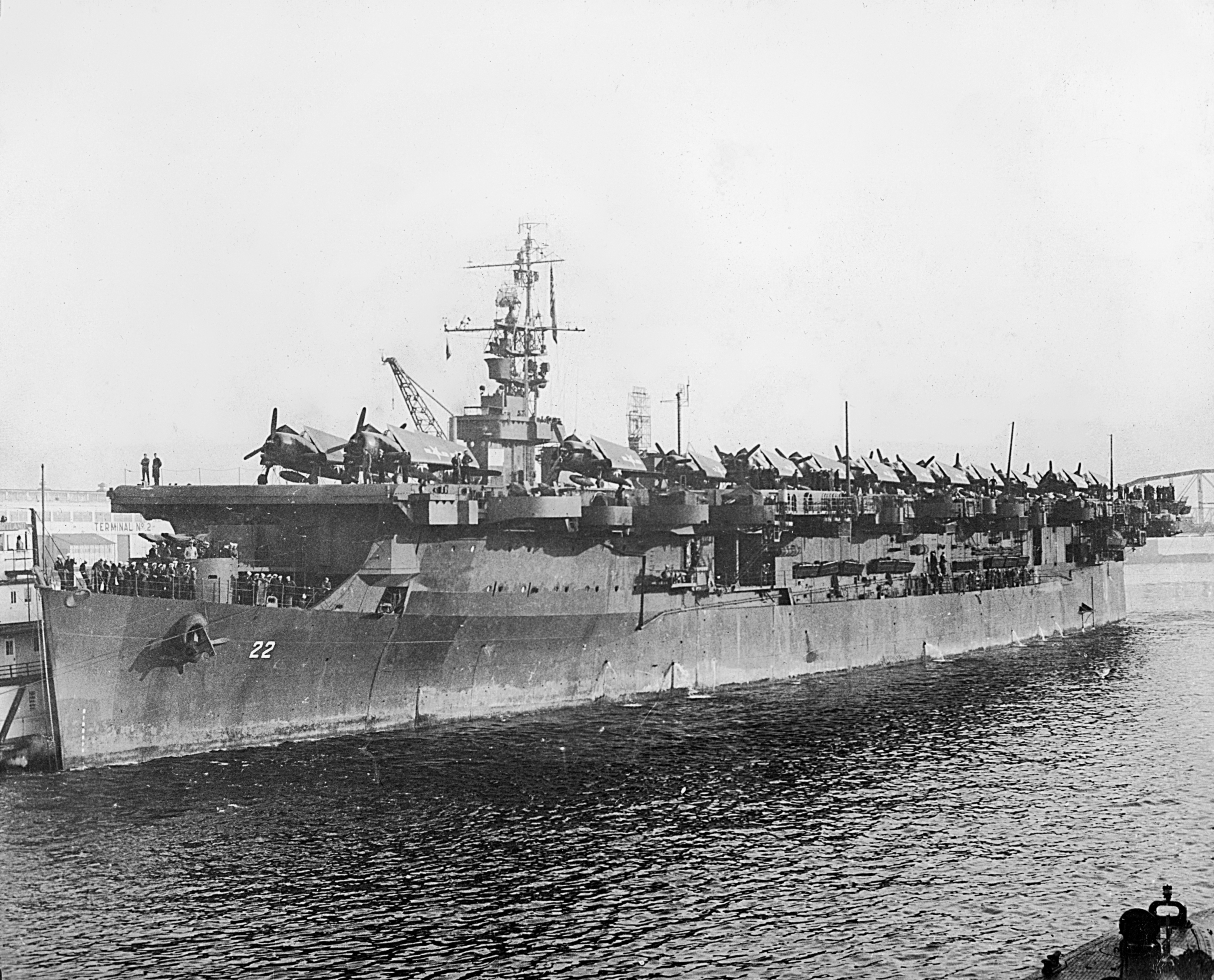
This post has been updated with additional details of a 2015 National Oceanic and Atmospheric Administration expedition to assess the condition of USS Independence (CVL-22)
The dives of E/V Nautilus’ remotely operated vehicles on a sunken World War II carrier off the Farallon Islands is the first in a “New Vector” partnership between Robert Ballard and his team and the Naval Historical Foundation (NHF)—and the first step in his multi-year “Victory at Sea” exploration plan.
Foundation officials, whose relationship with Ballard dates to a time before his re-discovery of Titanic in 1985, said this partnership was prompted by his presentation at the foundation’s 90th anniversary dinner in March about his plans for exploration of exclusive economic zones and marine sanctuaries that include sunken Navy ships, such as the USS Independence (CVL-22) off the California coast.
The NHF’s chairman, retired Navy admiral “Bill” Fallon, and its president, retired rear admiral “Bud” Langston, started the ball rolling with a letter on this latest venture. What followed were several phone calls, two face-to-face meetings and a number of conference calls.
The idea was “to expand our global dialog about the maritime domain and inspire a new generation of naval history and maritime enthusiasts,” foundation officials said in an e-mail response to questions from USNI News. NHF is posting unique material on its website about the carrier and the dive.
Why Independence?

For NHF, it was her significance in World War II and the Cold War.
Among her firsts: Grumman Hellcats flying combat missions off her deck and outfitted for, and performing, night flight operations. She earned eight battle stars for her World War II service from Rabaul to Leyte Gulf and Okinawa.
In the Cold War, Independence participated in Operation Crossroads, the atomic bombs tests at Bikini Atoll. She was towed back to Pearl Harbor and later Hunter’s Point Naval Shipyard in San Francisco for study of the effects of nuclear warfare on naval vessels, additional decontamination and to serve as the original site of the Naval Radiological Defense Laboratory. The Navy sunk her off the Farallon Islands in 1951after subjecting the ship to an atomic bomb blast.
Last year, Independence was surveyed by an expedition sponsored by National Oceanic and Atmospheric Administration using a Boeing sonar and found surprisingly intact, reported USNI News last year.
“Her value today is also the study of the level of radioactive contamination still present in the ship” to determine if it still poses a hazard to human or marine life or if it decayed to background levels as expected, Dr. David Winkler, foundation historian, said in an e-mail response.
What this means is the dive is not only mapping the wreck but taking samples of sea life for further study. Rear Adm. Timothy Gallaudet, commander of the Naval Meteorology and Oceanography Command, was embarked on E/V Nautilus for the first dive.
Winker added, “We had an extremely short window of time to post our naval history material.” It was drawn from the foundation with help from historians and archivists at Naval History and Heritage Command, Navy Museum and the Library of Congress Veterans History Project.
One stroke of timing luck came when Winkler saw a letter in Naval History from retired Rear Adm. Dick Van Orden. He had served as a gunnery officer about the carrier and later as chief of naval research had worked with Ballard in the past. Now in his 90s and living in northern Virginia, Van Orden and Dr. Frank Blazich of the Naval History and Heritage Command were videotaped in the Navy Museum to provide oral history and informational interviews for the foundation about the carrier and the atomic tests.
As the deadline neared for posting, volunteers and ship historian John Lambert contributed short articles to the NHF website.
Matthew Eng, who handles the foundation’s website, said in an e-mail this is essentially Phase 1. “There will certainly be many lessons learned, but we are continuing to work toward exploring new avenues with Dr. Ballard and help the general public gain a new and enhance fascination with naval history.”
NHF officials said planning for the future explorations have already begun with Ballard and his Ocean Exploration Trust, NOAA, Office of Naval Research, Naval History and Heritage Command, Naval Meteorology and Oceanography Command and others.





